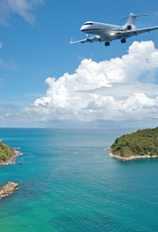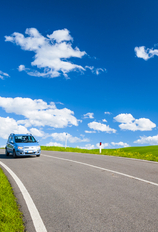Turquoise lagoons, jagged mountain peaks, dense jungles and iridescent pearls are just some of the attractions of French Polynesia, often simply called “Tahiti.” (Technically, Tahiti is just one of the 118 beautiful islands that make up French Polynesia.)
Picture a trip to French Polynesia and you probably imagine swimming in crystal-clear seas or snoozing under a palm tree, but there’s much more to do here — like learning a traditional dance, browsing a colorful market or exploring ancient temples. Dive into our slideshow to learn about these experiences and more … and don’t forget to check out our guides to lodging and getting around.
Learn the Hip-Swinging Heiva
No visit to French Polynesia is complete without a Tahitian dance performance. But visit between late June and late July and you’ll find most of the Society Islands caught up in the amazing dance frenzy that is the Heiva Festival. Tahitian dance was banned by missionaries from the London Missionary Society in the 1820s, as it was deemed too erotic. Once the French took control of the islands six decades later, dance was back on the agenda, although not in its original form. In the 1960s a Papeete schoolteacher named Madeleine Moua revived the traditional dance, and the Heiva Festival was born.
Performances and competitions are held in Papeete’s Maison de la Culture (cultural center); others take place in Bora Bora, Moorea and Huahine.
Those who want to don a coconut bra and grass skirt and shake their hips vigorously can learn the moves through the long-established Ori Tahiti International School of Tahitian Dance.
Have a Picnic in Paradise
Bora Bora’s sensational lagoon — claimed to have seven shades of blue — is a playground for marine life. One way to soak it all in is with a “motu picnic.” Motus, or small islands, form a circle around the lagoon and are perfect places to view the majestic main volcanic island and its cloud-swathed peak, Otemanu.
A typical tour starts with snorkeling in the clear waters of the coral gardens, where the fish swim up to have their photos taken and the occasional moray eel slivers by. Later the boatman might scurry up a coconut tree to retrieve a tropical snack to accompany the barbecue feast. The day finishes with a wade in shallow waters among harmless stingrays and black-tipped reef sharks. The “Bora Bora Exclusive” tour from Moana Adventures and the “Lagoon Tour & Snorkeling with Lunch” option from Maohi Nui are two recommended excursions.
Explore the Marquesas by Cargo Ship
The Marquesas Islands are called the “Land of Men” for their hardy inhabitants, known for full-body tattoos, horsemanship and their ability to tame the wild environment. A journey to these remote rugged islands can be done in comfort while still experiencing their authentic characteristics and meeting the locals.
Cargo/passenger ship Aranui 3 makes the 933-mile journey from Tahiti to the Marquesas 17 times a year, visiting six of the islands. While burly men unload supplies for the islanders and take on precious copra (the dried meat of the coconut, used to make oil), passengers take excursions to villages, archaeological sites and the grave of French artist Paul Gauguin, who died on Hiva Ora Island in 1903. The 14-day voyage includes two relaxing days at sea, allowing plenty of time for passengers to attend lectures or lie by the pool.
Visit Ancient Temples
Tales of human sacrifices and jungles dotted with stone tikis and remnants of ancient temples make for a real “Boys’ Own” adventure. French Polynesia has a number of sites where the islands’ earliest inhabitants worshiped their many gods. Stone temples called marae were also royal compounds and meeting places, while legend says human sacrifices were performed up until the mid-18th century.
While marae and tikis (human-like stone figures) are found everywhere, the islands of Raiatea and Huahine have the most extensive and best preserved. Raiatea is known as the sacred island; its huge Taputapuatea marae, dating back to 1000 A.D., was the central temple of eastern Polynesia at that time. Nearby Huahine’s marae are believed to be even older and housed the island’s eight royal chiefs. You can explore them on your own, but if you’d prefer a tour, Island Eco Tours offers half- and full-day 4WD tours led by anthropologist Paul Atallah, who explains Huahine’s rich cultural sites.
Advice from a Traveler Who’s Been There
South Pacific Cruise by travelmel
“History buffs can visit multiple maraes — outdoor ancient worship temples used in old Polynesia for ceremonial purposes. Many were destroyed or abandoned with the arrival of Christianity in the 19th century, but there are still high concentrations on Huahine and Raiatea.” Read more!
Sleep Over the Sea
Falling asleep to the gentle lapping of lagoon waters and waking up to a refreshing dip are the lures of the overwater bungalow. Nothing quite says French Polynesia like this iconic thatched hut on stilts, invented in Moorea in the 1960s.
Today overwater bungalows have morphed into mini-hotel suites with plunge pools (such as the opulent Four Seasons Resort in Bora Bora), although the classic conical one-room and deck with stairs into the lagoon still exists (the Hotel Maitai in Bora Bora is an example of the original style). The stroll along the pontoon to a secluded room is enticingly romantic, while the glass floor panel reveals marine creatures swimming below.
Overwater bungalows aren’t cheap, but when in French Polynesia the experience is de rigueur. Bed down in one of these in the Society Islands or farther afield in Rangiroa and Tikehau in the Tuamotus.
Go Diving for Pearls
It’s not hard to find a pearl shop in French Polynesia; they are as prolific as the reef sharks in the lagoons. But visiting a pearl farm before a shop visit is the best way to learn about the exotic Tahitian black pearls, known as the pinctada margaritifera.
Start with a visit to the to the Robert Wan Pearl Museum in Papeete to see gorgeous items such as a pearl-encrusted prayer book that belonged to Charles II of France. At the Bora Bora Pearl Company’s farm, you can dive with a guide for your own string of oysters and keep the pearl! Although it is a lottery (not every oyster produces a gem), the owners guarantee they’ll give you a pearl from their shop if you don’t strike a lucky oyster. The farm explains the intensive process of how pearls are cultured and harvested.
If you simply want to visit a farm without the dive, there are numerous other options, including Tahaa’s Champon Pearl Farm; the owners will explain how the farm operates and — of course — offer the opportunity to purchase some pearl souvenirs. Note that these excursions tend to be more about shopping than education.
Advice from a Traveler Who’s Been There
French Polynesia aboard the M/S Paul Gauguin by SDanielT
“We did the Black Pearl farm visit/snorkeling excursion. After riding an outrigger canoe to the pearl farm it was briefly informative but seemed to quickly transform into a sales pitch for the pearls. We spent an hour then waiting for everyone to finish buying pearls. A short snorkeling trip to a shallow area lasted about 45 minutes … then the canoe dropped us off at a private motu where the ship had set up a huge BBQ for all the passengers. It was a very nice and relaxing time for the rest of the day.”
Read more!
Get a Taste of Papeete
Shopping for sarongs, straw hats, baskets, carvings and pearls is a multi-sensory experience at Papeete’s public market. The sweet aromas of vanilla and coconut pervade the air, while musicians play their ukuleles and the vibrant colors of the flower and fruit stalls make for nonstop photo ops. While the market is open all day, it’s at its most active in the early morning when the fresh fish arrives, and on Sunday mornings when ladies shop for prepared meals for big family lunches.
When the sun goes down, those in the know head to the waterfront Place Vaiete to dine at the roulottes, or food trucks, which sell an amazing array of meals from poisson cru (marinated raw fish in coconut milk) to Asian stir-fry dishes and crepes. It’s the best and cheapest food in the islands.
Advice from a Traveler Who’s Been There
South Pacific Cruise by travelmel
“We spent our afternoon on embarkation day covering the waterfront on foot, ducking into small shops and enjoying a seafood lunch at Jack Lobster atop the Vaima Center, a four-level shopping and dining complex. It was so close to our dock that we could see many of our shipmates returning from the Marche du Papeete, a fabulous market with a French feel, with flower arrangements for their cabins.”
Read more!
See a Lagoon within a Lagoon
What evocative images are conjured up by the words “Blue Lagoon”? In Rangiroa, the largest atoll in the Tuamotus, adventurers will find not one but two lagoons. A long, narrow grouping of 415 small motus strung together in a misshapen circle, Rangiroa harbors a lagoon so large the entire island of Tahiti could fit within it. And in this vast expense of water is a tiny little patch of paradise called the Blue Lagoon.
It’s an hour-long boat ride from the main town of Avatoru, and once there, it’s bliss. The water is aquamarine, the sand golden and little reef sharks swim up in hope of a morsel once the beach barbecue is done. Several operators run day-long picnics tours to this sublime spot; see Tahiti-Tourisme.com for a list.
Advice from a Traveler Who’s Been There
French Polynesia aboard the M/S Paul Gauguin by SDanielT
“Rangiroa. Another day of diving! A dozen sharks met us as soon as we entered the water — loved it! Rained pretty hard on us the afternoon as we departed Rangiroa. A very pretty scene though seeing the second largest atoll in the world!”
Read more!
Ride an ATV into the Jungle
Beyond the beaches and the lagoons, there is plenty to do in these volcanic islands. An ATV tour of Moorea is an action-packed eye-opener. Quad riders follow their leader over the rough roads of the Opunohu Valley up to the Belvedere lookout for views of stunning Cook’s and Opunohu Bays, meandering past ancient stone temples on the way. There’s a stop at the Opunohu Agricultural College for a guided walk through the vanilla and fruit plantations and a chance to sample pineapples and tasty jams. ATV Moorea Tours is one recommended operator.
Bora Bora’s dense jungle also hides many secrets, unveiled during a 4WD tour of its rugged interior with Tupuna Mountain Safari. Vehicles negotiate unbelievably steep and narrow tracks to visit one of the four sets of cannons installed on the island during WWII as well as old bunkers buried under twisted vines.
Lava tubes, steep valleys, precipitous peaks and waterholes ideal for swimming are stops on Tahiti Safari Expedition’s 4WD and hiking tours on Tahiti, French Polynesia’s largest island.
Advice from a Traveler Who’s Been There
South Pacific Cruise by travelmel
“The first day, we took a 4WD island tour; we were fortunate to be the last of our group off the tender, and ended up having a safari vehicle all to ourselves (they usually hold about 10). The ride is bumpy — we were warned of that ahead of time — but the fact that there were no bodies cushioning us on either side of the wooden benches also meant that for each sharp turn or dirt pile, my behind would slide to and fro, or bounce clear off the seat. It was great fun, even though my arms were sore the next day from holding on for dear life!”
Read more!
Hang 10 in Tahiti Iti
Surfers flock to Tahiti Iti (little Tahiti), the tiny island connected to Tahiti, to try their luck on the infamous Teahupoo wave. The Billabong Pro Tahiti surf competition takes place there every August, when four-time title winner Kelly Slater attempts to ride the notoriously dangerous “heavy” wave.
Non-surfing travelers, however, can take a boat ride with Teahupoo Tahiti Safari to view the wave and reef break from a safe distance. The day tour also includes a coastal hike, snorkeling, swimming in a waterfall-fed rock pool and perhaps a spot of dolphin watching. With just two five-mile-long roads and a handful of pensions, Tahiti Iti is remote and best explored on a small group tour.
The dry season in French Polynesia runs from May through October, with tourism peaking in July and August; this is when you’ll find comfortable temperatures and lots of sunshine, but also croweded resorts and high rates. If you travel during the wet season, you’ll enjoy lower rates but also higher humidity and a greater chance of rainstorms. Holiday periods such as Christmas, New Year’s and Easter are also quite busy.
Between the pricey airfare and the glitzy resorts, French Polynesia can be a real budget buster for travelers. You can cut costs by staying in family-run pensions or renting a villa with a kitchen where you can make your own meals. Keep an eye out for package deals that include both airfare and accommodations, as these can offer better prices than booking both individually. Traveling outside the peak months of May through October can also save you quite a few bucks.
— written by Caroline Gladstone
 vacation
$2198+
vacation
$2198+
 cruise
$12399+
cruise
$12399+
 Car Rental
$19+
Car Rental
$19+



